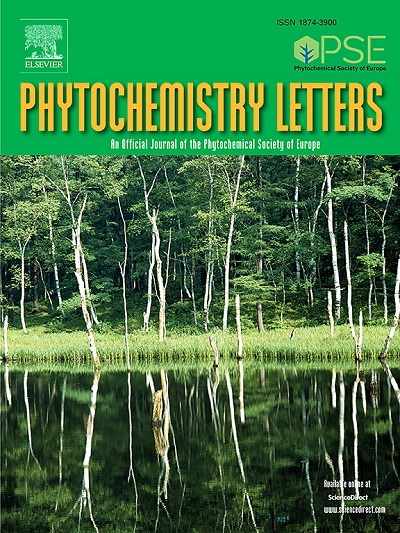New coumarins from a hot water extract of Daphne mezereum bark
IF 1.4
4区 生物学
Q4 CHEMISTRY, MEDICINAL
引用次数: 0
Abstract
This study aimed to investigate the low-molecular weight compounds in a hot water extract of the bark of Daphne mezereum L. (Thymelaceae), a medicinal plant with a longstanding medicinal use in Scandinavia. Among the fourteen isolated compounds, two coumarin glycosides are reported for the first time, and four known compounds were reported in D. mezereum for the first time. Their structures were elucidated by NMR, HRESIMS and methanolysis. The new compounds were identified as 3-(2-(β-d-glucopyranosyloxy)-4-[(7-hydroxy-6-methoxy-2-oxo-2H-chromen-3-yl)oxy]phenyl)propanoic acid (9), and 7-hydroxycoumarin-5,8-di-β-d-glucopyranoside (11). Cytotoxic effects were assessed by the MTT assay, while the anti-inflammatory effects were assessed by measuring the inhibition of NO-release by dendritic cells. The results revealed negligible cytotoxic effect and NO-inhibitory activity of compounds 9 and 11.
从达芙妮树皮热水提取的新香豆素
本研究旨在研究在斯堪的纳维亚半岛具有长期药用价值的药用植物达芙妮(百里香科)树皮热水提取物中的低分子量化合物。14个分离得到的化合物中有2个为首次报道的香豆素苷类化合物,4个为首次报道的已知化合物。它们的结构经NMR、hresms和甲醇解确证。新化合物鉴定为3-(2-(β-d-葡萄糖吡喃氧基)-4-[(7-羟基-6-甲氧基-2-氧基-2-铬-3-基)氧]苯基)丙酸(9)和7-羟基香豆素-5,8-二-β-d-葡萄糖吡喃苷(11)。通过MTT法评估细胞毒性作用,通过测量树突状细胞释放no的抑制作用来评估抗炎作用。结果显示,化合物9和11的细胞毒作用和no抑制活性可以忽略不计。
本文章由计算机程序翻译,如有差异,请以英文原文为准。
求助全文
约1分钟内获得全文
求助全文
来源期刊

Phytochemistry Letters
生物-生化与分子生物学
CiteScore
3.00
自引率
11.80%
发文量
190
审稿时长
34 days
期刊介绍:
Phytochemistry Letters invites rapid communications on all aspects of natural product research including:
• Structural elucidation of natural products
• Analytical evaluation of herbal medicines
• Clinical efficacy, safety and pharmacovigilance of herbal medicines
• Natural product biosynthesis
• Natural product synthesis and chemical modification
• Natural product metabolism
• Chemical ecology
• Biotechnology
• Bioassay-guided isolation
• Pharmacognosy
• Pharmacology of natural products
• Metabolomics
• Ethnobotany and traditional usage
• Genetics of natural products
Manuscripts that detail the isolation of just one new compound are not substantial enough to be sent out of review and are out of scope. Furthermore, where pharmacology has been performed on one new compound to increase the amount of novel data, the pharmacology must be substantial and/or related to the medicinal use of the producing organism.
 求助内容:
求助内容: 应助结果提醒方式:
应助结果提醒方式:


